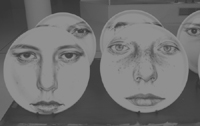Austin is sitting in a chair with the audience while presenting on PowerPoint.
...
Austin: One of the underlying principles in concept mapping is that the learner can see visually relationships between elements of what he or she is learning.
Herman: Such as logical connections like cause and effect, subordination giving examples, and so on?
Austin: Exactly. This enables us go outside a top-down approach, to escape from two dimensional modeling and enter into three dimensional, collaborative representations.
Herman: Isn’t concept mapping much more than this? Doesn’t it give everyone a chance of feeling involved, and to give them a chance to rename the elements, and thus rewrite the maps?
Austin: Again, exactly. Yes. That’s what I meant by collaboration.
Herman: So this is why you leave the chair empty and give your presentation from within the audience instead of from the front of the room? To enhance the atmosphere of collaboration?
Austin. Precisely. But it also allows me to avoid neckstrain caused by constantly swinging between the screen and the audience. This way I’m much more relaxed.
Voiceover
Special thanks to Lawrie Hunter for the introduction to concept maps and Ron C. de Weijze for fine tuning the description.
Hope citing these people shows I am NOT MAKING THIS UP.
And I did applaud Lawrie sitting among the audience as an example of the philosophy applied.
...













1 comment:
nice
Post a Comment